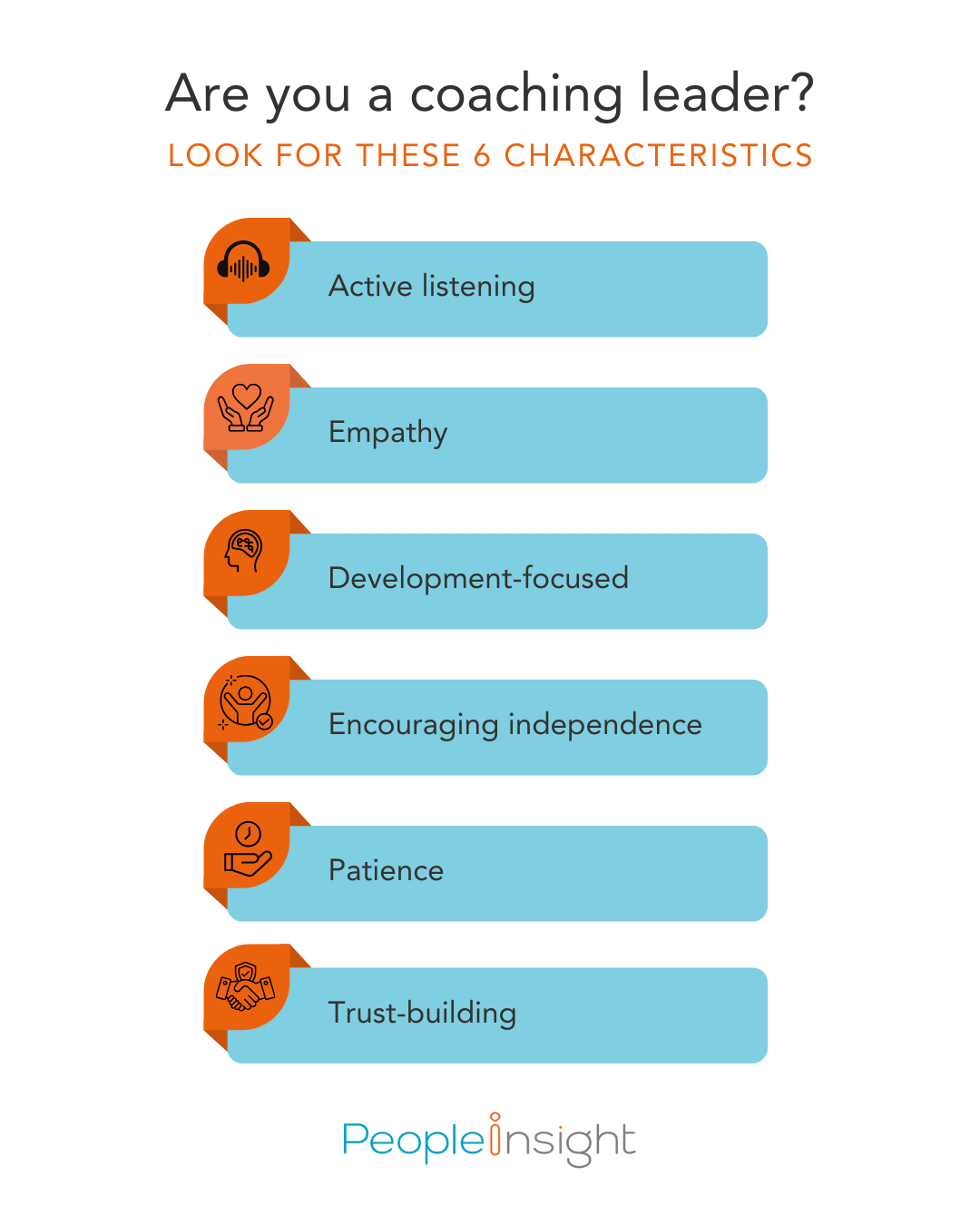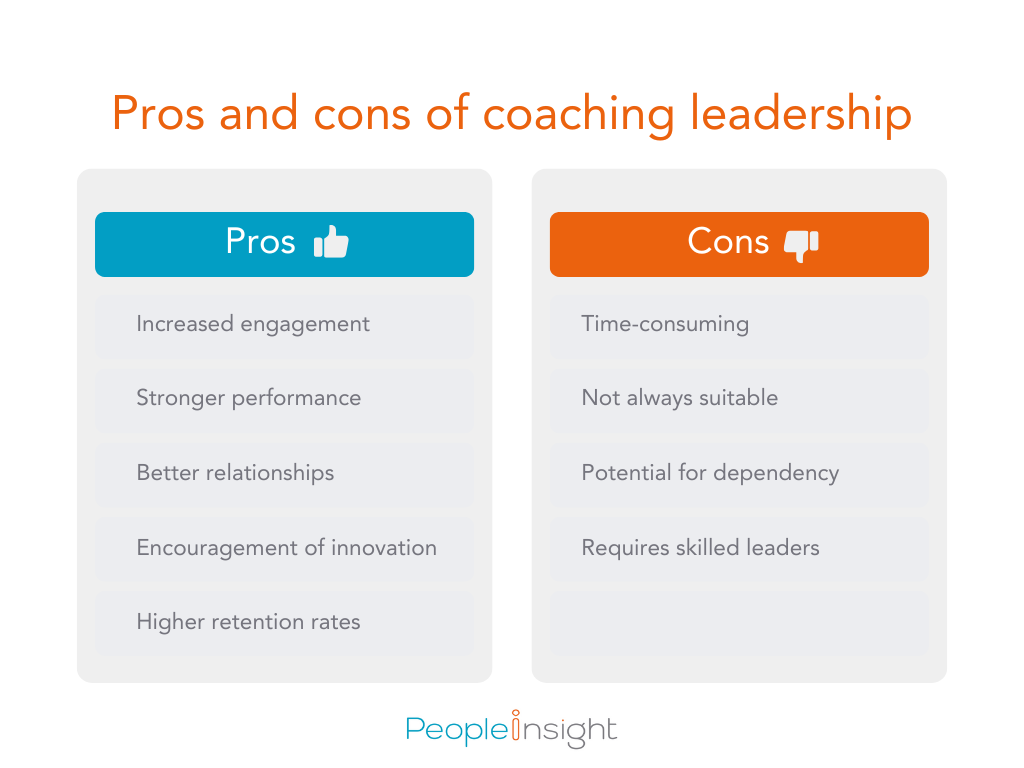
No two leaders are the same — we all operate, motivate and support our team in our own unique ways. And understanding your leadership style is one of the most effective ways to bring out the best in your employees.
At People Insight, we created a Goleman leadership style quiz, and out of over 3,400 participants, an impressive 41.5% identified as coaching leaders. This was by far the most popular leadership style, with democratic leadership coming in second at 22.8%.
So why does this matter? Because when leaders understand their natural style, they can use it more effectively to develop their employees, improve performance and create a workplace where people feel valued and motivated. Coaching leadership is a style that focuses on growth — helping employees unlock their potential and guiding them, step-by-step, towards success.
But what exactly is coaching leadership? How does it work in practice and what are the pros and cons? Let’s explore.
Related: Top 360 feedback trends to watch in 2025
Coaching leadership is all about development. Instead of simply instructing employees on what to do, coaching leaders guide them, helping them build skills, confidence and independence. This leadership style is centred around asking the right questions, providing constructive feedback and encouraging employees to think critically about their work.
A coaching leader doesn’t just focus on short-term goals; they look at long-term growth. This means creating a performance management process that allows for regular one-to-ones and mentoring conversations, with an emphasis on learning and self-improvement. Rather than micromanaging, coaching leaders create an environment where employees feel supported but also challenged to develop their capabilities.
This style is particularly effective in organisations that value innovation, continuous improvement and employee engagement. When people feel invested in and encouraged to grow, they are more likely to stay motivated and perform at their best.
So, what makes a coaching leader stand out? There are a few defining traits that set them apart from other leadership styles:

Looking for some well-known examples of coaching leaders? Here are just a few examples:
As a legendary basketball coach, Phil Jackson didn’t just train players; he developed them. Known as the “Zen Master,” Jackson used mindfulness and a holistic coaching approach to guide teams like the Chicago Bulls and Los Angeles Lakers to multiple championships. His leadership was about more than tactics; it was about helping players grow mentally and emotionally as well.
Researcher and author Brené Brown is a strong advocate for leading with empathy and vulnerability — both key aspects of coaching leadership. She encourages leaders to be authentic, to create an environment where employees feel safe to take risks and to see failure as part of the learning process.
The founder of Virgin Group, Branson is well known for his people-first leadership approach. He believes that by supporting employees and encouraging their development, they will, in turn, take better care of customers. His emphasis on mentorship, empowerment and trust aligns closely with coaching leadership principles.
Let’s take a look into the advantages and potential drawbacks of this coaching style.

There’s a reason coaching leadership is such a popular style. It comes with several advantages:
Despite its many benefits, coaching leadership does have some challenges:
Because coaching leaders are focused on development, the feedback they receive in a 360 feedback assessment often highlights their strengths in mentorship and support. However, it can also reveal areas for improvement. Here are some common themes we’ve noticed as executive coaches:
Related: 360 Feedback for managers — 20 examples on how to give feedback to your boss
If you naturally lean towards coaching leadership, here are some ways to maximise its effectiveness:

Coaching leaders often prioritise autonomy, but employees still need structure. Without clear expectations, they may feel lost or unsure about priorities. Define what success looks like for each person and ensure they understand their responsibilities. This doesn’t mean micromanaging — it means giving employees a clear direction while allowing them space to find their own way of achieving goals.
Coaching leadership thrives on ongoing conversations, not just annual reviews. Regular one-to-ones allow you to provide real-time feedback, discuss challenges and celebrate progress. These check-ins shouldn’t just be about performance — they should also cover development goals and personal growth.
Rather than dominating these meetings, consider asking open-ended questions, which lend themselves to more fluid conversations:
Giving employees space to reflect and share their thoughts makes these sessions more productive and meaningful.
While coaching leadership is highly effective, it’s not always the right approach for every situation. Some moments require decisive leadership — such as during a crisis or when an employee is new and needs more guidance.
Knowing when to shift from coaching to a more directive style is key. If an employee lacks the necessary skills for a task, they may need more instruction before they can problem-solve on their own. Similarly, if a team is facing a tight deadline, there may not be time for a coaching conversation. The best coaching leaders are flexible, adapting their approach based on the needs of the moment.
One of the core principles of coaching leadership is helping employees develop their own problem-solving abilities. Encouraging self-reflection helps them become more independent and resilient. Instead of giving immediate solutions, prompt employees to think through challenges themselves.
For example, if someone is struggling with a project, rather than saying, “Here’s what you should do,” ask, “What options have you considered?” or “What do you think is the best course of action?” This approach encourages critical thinking and builds confidence in their own decision-making.
You can also introduce self-assessments or reflective exercises after key projects, encouraging employees to consider what worked, what didn’t and what they would do differently next time.
Coaching leaders walk a fine line between supporting employees and giving them the space to grow. If you’re too hands-off, employees might feel unsupported. If you’re too involved, they may become overly dependent on your input.
A useful method to strike this balance is the Situational Leadership Model, which suggests adjusting your level of direction and support based on an employee’s competence and confidence. Someone who is new to a role might need more structured guidance at first, while a more experienced employee might thrive with greater independence.
Encourage employees to take ownership of their work by involving them in decision-making and giving them responsibilities that stretch their capabilities. Trust them to make choices, and if mistakes happen, treat them as learning opportunities rather than failures.
Great coaching leaders are always looking to improve. One of the best ways to do this is through 360-degree feedback, which gathers insights directly from your employees. This type of feedback can help you identify strengths in your leadership as well as areas that might need adjustment.
For example, you might find that employees appreciate your mentorship but wish you were more decisive in certain situations. Or you might discover that some employees need clearer guidance rather than open-ended coaching. These insights allow you to refine your approach and become a more effective leader.
Coaching leadership has the power to transform workplaces, creating an environment where employees feel valued and supported in their growth. But like any leadership style, it requires self-awareness and continuous improvement.
If you’re interested in understanding more about your leadership style and how it impacts those around you, 360 feedback is a great place to start. At People Insight, we provide various 360 models and detailed feedback assessments to help leaders develop and refine their approach. Get in touch with us today to learn more.
